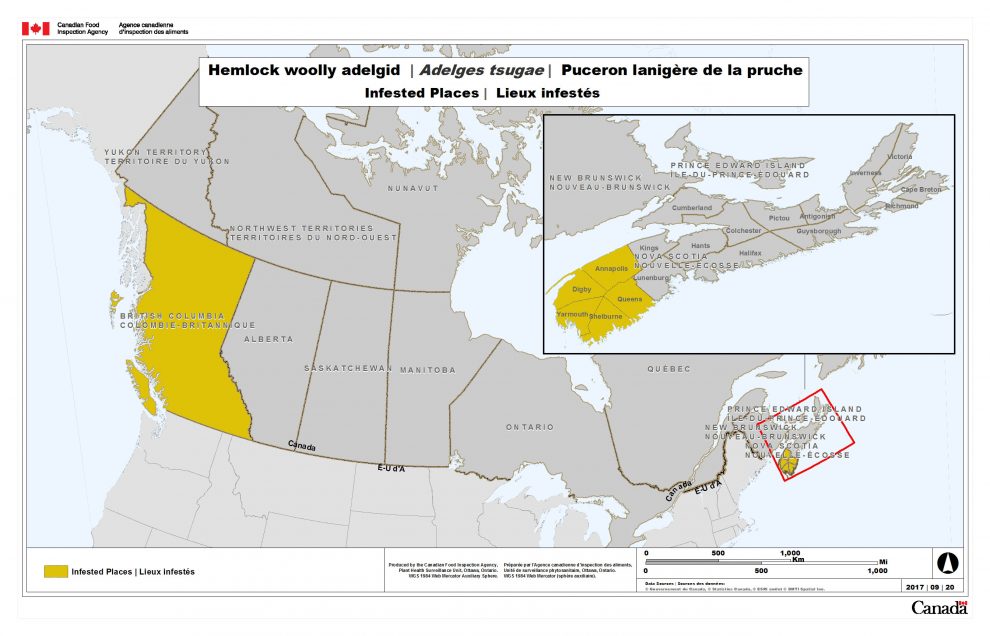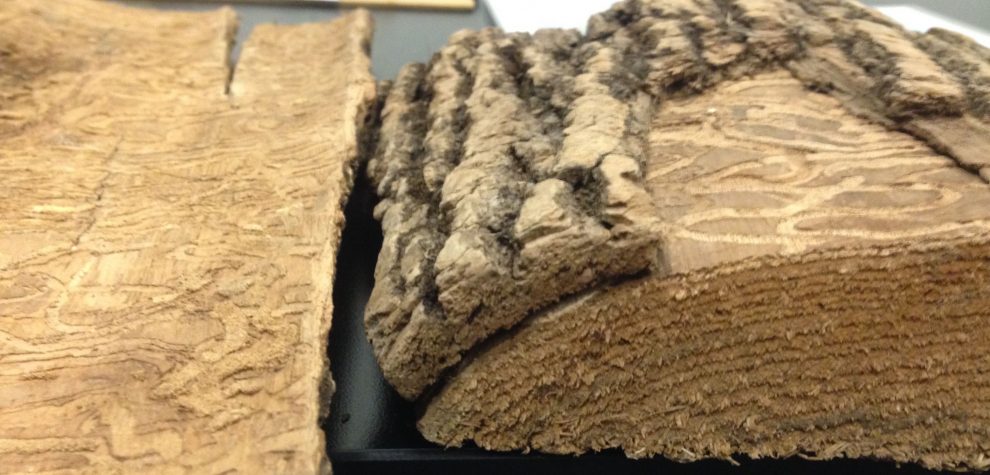Invasive species
Public awareness can help stop spread of tree-destroying bugs, says CFIA
The hemlock woolly adelgid and emerald ash borer are most likely here to stay

caption
Hemlock woolly adelgid and the emerald ash borer are new to Nova Scotia's ecosystems and pose a risk to the province's forests.Two kinds of invasive, tree-killing insects have found a new home in Nova Scotia, and experts are asking for the public’s help to stop them from spreading.
The hemlock woolly adelgid, a minuscule bug just over a millimetre long, was discovered in southwest Nova Scotia last August. The emerald ash borer, a small, metallic-green beetle, turned up in September. The pests destroy the trees they’re named for: hemlock and ash, respectively.
“There’s very little you can do to get rid of them once they’ve infested a tree,” said Ron Neville, a plant biologist with the Canadian Food Inspection Agency. CFIA is responsible for monitoring and preventing the spread of invasive species because it can quarantine plants.
Neville spoke at an information session at the Halifax Central Library on Saturday. The event was hosted by Giants of Nova Scotia, a not-for-profit organization that aims to educate the public about threats posed to trees by the mentioned invasive species.
The group’s founder, Tom Rogers, is a woodland owner concerned about the potential impact of the bugs.
“I started looking around my own land, thinking, ‘this would just be awful to lose,’” he said.
While neither of the pests are directly harmful to humans, the same can’t be said for their impact on the ecosystem.
Hemlock woolly adelgid
The hemlock woolly adelgid is native to Asia. It’s thought to have been brought to Virginia by imported Japanese hemlock trees in the 1950s and spread north, Neville said.
The bug uses a straw-like mouth to suck nutrients from the base of needles, usually killing the tree in five to 15 years. The branches of an infested tree are covered in small, white, cotton-like bits of fluff attached to the branch near the needles.
Hemlock trees are a “foundational species,” Neville said, as many other plants, insects and animals rely on them to survive.
CFIA has imposed regulations and quarantines on certain wood products in the areas affected by the beetles. Hitching a ride on firewood is one of the main ways they can spread, so firewood of any kind is prohibited from leaving Digby, Queens, Shelburne, Yarmouth or Annapolis counties, unless authorized.

caption
A map of hemlock woolly adelgid-infested areas of Canada.“People can spread it long distances very quickly,” said Neville. “Cape Breton has beautiful, old, hemlock stands and a person could could move it there in a few hours when it could take 40 or 50 years to move it naturally.”
His team is working with researchers to come up with strategies to manage the pests. In the U.S., states have used pesticides and bio-control, the release of another species that preys on the pest. Given the differences in ecosystems, however, what works somewhere else could have negative effects in Nova Scotia.
Emerald ash borer
The emerald ash borer is an aggressive beetle: once infested, trees have almost a 100 per cent chance of dying within a few years, said Neville.
The beetles lay eggs on the bark, which hatch into larvae and burrow into the tree, consuming the nutrient-rich tissue underneath the bark. They re-emerge to mate and begin the infestation cycle again, eventually hollowing out a layer of the tree.
“If you’re a tree, this area between the bark and the wood, this is where you’re alive,” said Neville.

caption
The emerald ash borer burrows underneath the bark and tunnels through the nutrient-rich layer above the wood, killing the ash tree in just a few years.The borer came to North America in 2002, likely on wooden shipping pallets sent from Asia to Detroit. The bugs have spread through much of Ontario and Quebec, and have made it as far west as Winnipeg, said Neville. Aside from the report from Bedford, a small pocket has been discovered in northwestern New Brunswick.
Since they attack the crowns of the trees first, Neville said, it can take years before they’re discovered.
Working towards a solution
He said CFIA is working with the Canadian Forest Service, as well as municipalities, to find the best way to deal with the beetles. Since they won’t emerge from inside the trees to mate until spring, there is still some time to figure out an appropriate strategy. Some cities have cut down the trees, while others inject them with pesticides, but those methods need to be evaluated for use in Nova Scotia.
“You need to decide what the right product is and what kind of effects it can have on other species,” Neville said, adding that while CFIA is working to slow their spread, public awareness can make a huge difference.
Rogers suggests those who spend time in wooded areas, like photographers, hikers and campers, should look for signs of infestation. Infestation signs can include small beetle exit-holes on ash trees or white fluff near the bases of needles on hemlock.
“If they know and are aware and you can enlist some of those people to help, then all of the sudden we have a lot of boots on the ground,” he said.
Neville encourages anyone who encounters the beetles to contact the CFIA. He suggests that Nova Scotians think twice before moving firewood from one place to another.
Rogers isn’t as diplomatic.
“I say to people, ‘don’t move your firewood.’ It’s just not worth it,” he said.

